

Prehistoric Scotland. Category:Neolithic Scotland. Standing Stones of Stenness. The Standing Stones of Stenness The Standing Stones of Stenness is a Neolithic monument on the mainland of Orkney, Scotland.
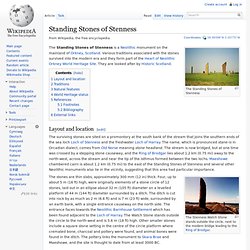
Various traditions associated with the stones survived into the modern era and they form part of the Heart of Neolithic Orkney World Heritage Site. They are looked after by Historic Scotland. Layout and location[edit] Skara Brae. Skara Brae /ˈskærə ˈbreɪ/ is a stone-built Neolithic settlement, located on the Bay of Skaill on the west coast of Mainland, the largest island in the Orkney archipelago of Scotland.
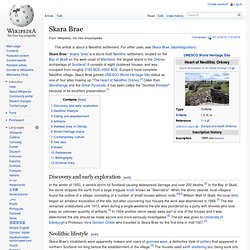
It consists of eight clustered houses, and was occupied from roughly 3180 BCE–2500 BCE. Europe's most complete Neolithic village, Skara Brae gained UNESCO World Heritage Site status as one of four sites making up "The Heart of Neolithic Orkney. " Skara Brae. Ness of Brodgar. Ness of Brodgar is an archaeological site covering 2.5 hectares (6.2 acres) between the Ring of Brodgar and the Stones of Stenness in the Heart of Neolithic Orkney World Heritage Site near Loch of Harray, Orkney, in Scotland.
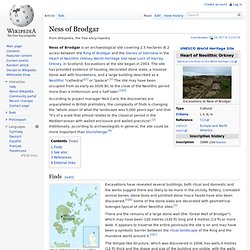
Excavations at the site began in 2003. The site has provided evidence of housing, decorated stone slabs, a massive stone wall with foundations, and a large building described as a Neolithic "cathedral"[1] or "palace".[2] The site may have been occupied from as early as 3500 BC to the close of the Neolithic period more than a millennium and a half later.[1][3] Finds[edit] Ness of Brodgar Ness of Brodgar shown within Orkney Excavations have revealed several buildings, both ritual and domestic and the works suggest there are likely to be more in the vicinity.
There are the remains of a large stone wall (the "Great Wall of Brodgar") which may have been 100 metres (330 ft) long and 4 metres (13 ft) or more wide. Prehistoric roof tiles were used in Ness of Brodgar. Ring of Brodgar. The Ring of Brodgar (or Brogar, or Ring o' Brodgar) is a Neolithic henge and stone circle on the Mainland, the largest island in Orkney, Scotland.

It is part of the UNESCO World Heritage Site known as the Heart of Neolithic Orkney General information[edit] Neolithic discovery: why Orkney is the centre of ancient Britain. Drive west from Orkney's capital, Kirkwall, and then head north on the narrow B9055 and you will reach a single stone monolith that guards the entrance to a spit of land known as the Ness of Brodgar.
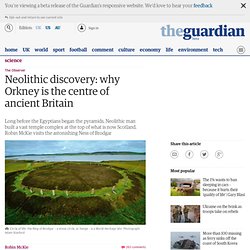
The promontory separates the island's two largest bodies of freshwater, the Loch of Stenness and the Loch of Harray. At their furthest edges, the lochs' peaty brown water laps against fields and hills that form a natural amphitheatre; a landscape peppered with giant rings of stone, chambered cairns, ancient villages and other archaeological riches. Stonehenge Precursor Found? Island Complex Predates Famous Site. On an island off Britain's northern tip, new discoveries suggest a huge Stone Age ritual complex is older than Stonehenge. But age is only the half of it. Researchers say the site may have in fact been the original model for Stonehenge and other later, better-known British complexes to the south. NGS final ReportFEB10.pdf. Maeshowe. Maeshowe Maeshowe Entrance Maeshowe (or Maes Howe; Norse: Orkhaugr[1]) is a Neolithic chambered cairn and passage grave situated on Mainland, Orkney, Scotland.

It was probably built in around 2800 BC. It gives its name to the Maeshowe type of chambered cairn, which is limited to Orkney. Callanish Stones. The Callanish Stones (or "Callanish I", Clachan Chalanais or Tursachan Chalanais in Gaelic) are an arrangement of standing stones placed in a cruciform pattern with a central stone circle.

They were erected in the late Neolithic era, and were a focus for ritual activity during the Bronze Age. They are near the village of Callanish (Gaelic: Calanais) on the west coast of Lewis in the Outer Hebrides, Scotland. Location[edit] The Callanish Stones (grid reference NB213330) are situated on a low ridge above the waters of Loch Roag with the hills of Great Bernera as a backdrop.[1] Management[edit] The Callanish Stones are managed by Historic Scotland. Description[edit] Calanais Standing Stones Property Detail. Circles of stoneThe main monument is extraordinary – a cross-shaped setting of stones, centred on a circle of tall stones.

At its heart stands a solitary monolith 4.8m high. Lines of smaller stones radiate from the circle to east, west and south. Cairnpapple Hill. Cairnpapple Hill is a hill with a dominating position in central lowland Scotland with views from coast to coast.
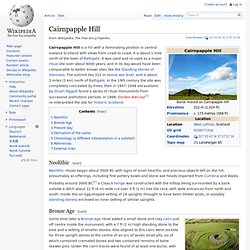
It is about 1 mile north of the town of Bathgate. It was used and re-used as a major ritual site over about 4000 years, and in its day would have been comparable to better known sites like the Standing Stones of Stenness. The summit lies 312 m above sea level, and is about 2 miles (3 km) north of Bathgate. In the 19th century the site was completely concealed by trees, then in 1947–1948 excavations by Stuart Piggott found a series of ritual monuments from successive prehistoric periods.
In 1998, Gordon Barclay[1] re-interpreted the site for Historic Scotland. Neolithic[edit] Neolithic rituals began about 3500 BC with signs of small hearths, and precious objects left on the hill, presumably as offerings, including fine pottery bowls and stone axe heads imported from Cumbria and Wales. Skara Brae. Scotland in the Stone Age. The Stone Age The Stone Age, or Neolithic period, had its origins in Northern Europe more than 9000 years ago, towards the end of the last Ice Age.
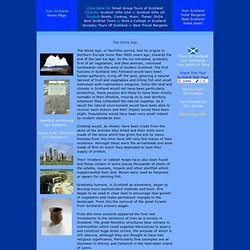
As the ice retreated, gradually first of all vegetation, and then animals, colonised northwards into the area of modern Scotland. The first humans in Scotland who followed would have been hunter-gatherers, living off the land, gleaning a natural harvest of fruit and vegetables and killing fish and small mammals with rudimentary weapons. Since the land and climate in Scotland would not have been particularly productive, these peoples are likely to have been mostly nomadic in their lifestyle, moving on to new territory whenever they exhausted the natural supplies.
As a result the natural environment would have been able to recover each season and their impact would have been slight. Prehistoric Stones List: Scotland. For your convenience when travelling and planning an itinerary we have listed Scotland’s Prehistoric attractions by area (see our map on Scotland home page). Further details and photographs may be in our Attractions section or Articles section. Angus Aberlemno Sculptured Stones At Aberlemno, 6 miles (10km) northeast of Forfar, Angus, on the B9134. Historic Scotland. Cross-slab in the churchyard with interlaced decoration and Pictish symbols. Ardestie Earth-House 1 mile (1.6km) north of Monifieth, Angus, off the A92. Carlungie Earth-House 2.5 miles (4km) northeast of Monifieth, Angus, on the B961. St Orland's Stone In a field near Cossans farm, 4.5 miles (6.8km) west of Forfar, Angus, off minor road from A92/A928. Argyll and Bute, Isle of Arran Achnabreck Cup and Ring Marks 1.5 miles (2.4km) northwest of Lochgilphead, Argyll and Bute, on A83/A816.
Ancient Scotland. Mesolithic - Early people. In the time line of prehistory, the period of earliest known occupation of Scotland by man is called the Palaeolithic (or Early Stone Age) - more than 10,000 years ago. The Mesolithic (or Middle Stone Age) period, from c 10,000 to 5000 years ago, dates from the end of the last Ice Age. This was a period of rising temperatures, reaching something like today’s; and rising sea levels, caused by melting glaciers. During the Mesolithic period Ireland became cut off from Britain by the sea, and Britain from Europe.
History - Scottish History. Archaeologists unearth Stone Age dwelling on the banks the of new Forth crossing - Scotland. THE remains of an ancient dwelling believed to be Scotland’s oldest house have been discovered on the banks of the River Forth. Experts say the Stone Age timber structure – which may have resembled the wigwams constructed by North American Indians – was built more than 10,000 years ago, possibly as a winter retreat, in the period after the last ice age.
It was discovered in a field outside the village of Echline, near South Queensferry, during routine archaeological excavations in advance of work on the new Forth Replacement Crossing over the Forth estuary and contained flint arrowheads used by the original occupants. Dated from the mesolithic era, the remains consist of a large oval pit, seven metres long and half a metre deep, with a series of holes which would have held upright wooden posts. They would have supported walls possibly made from animals skins, although some experts believe there may have been a flatter turf roof. Stone Age home found - News - Archaeology. Stone Age tomb unearthed in Scotland. Redheads. Wee ginger people.